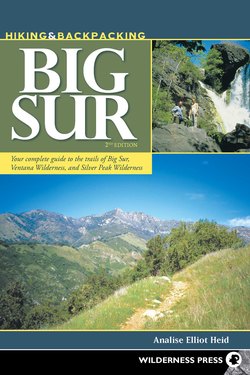Читать книгу Hiking and Backpacking Big Sur - Analise Elliot Heid - Страница 18
На сайте Литреса книга снята с продажи.
ОглавлениеTrip 2
CARMELO MEADOW, GRANITE POINT, & MOSS COVE TRAILS
LENGTH AND TYPE: 4.4-mile out-and-back
RATING: Easy
TRAIL CONDITION: Well maintained, good for kids
HIGHLIGHTS: Visit the Whaling Station Museum and adjacent Whalers Cabin Museum to learn about the area’s cultural history.
TO REACH THE TRAILHEAD: Once at Point Lobos, park in the lot just past the entrance kiosk. If that lot is full (often the case on weekends), bear right at the first fork and head north 0.3 mile to Whalers Cove. Follow the trail description from Whalers Cove, bypassing the 0.2-mile Carmelo Meadow Trail description.
TRIP SUMMARY: This hike begins amid colorful coastal wildflowers in Carmelo Meadow and leads to Whalers Cove, the former site of a prosperous whaling station. A short stroll up the road leads to the Whalers Cabin Museum and Whaling Station Museum, each of which display historical artifacts, diagrams, and photographs. The Granite Point Trail leads through dense Monterey pines to Coal Chute Point, which overlooks the surging surf and thick floating kelp mats. Keep a close watch for harbor seals and sea otters amid the kelp.
Trails at Point Lobos lead to jagged, rocky headlands, turquoise waters, and wind-sculpted pine forests.
Trip Description
The Carmelo Meadow Trail leads from the entrance road north to Whalers Cove or south toward Gibson Beach and Bird Island. Head north through Carmelo Meadow. In spring, grasses and herbacious plants give way to a spectrum of wildflowers. At 0.2 mile the Carmelo Meadow Trail ends at Whalers Cove and a junction with the Granite Point Trail. Turn left onto the Granite Point Trail and stroll 0.1 mile to the Whaling Station Museum and Whalers Cabin Museum (0.3 mile, 30').
WHALE TALES
In the 1850s, Chinese fishermen sailed to California in 30-foot junks in order to harvest abalone along these rocky shores. Their settlement at Whalers Cove consisted of about a dozen structures, one of which now houses the Whalers Cabin Museum. Artifacts and memorabilia span several time periods in the cultural history of the cove.
Portuguese whalers arrived at Point Lobos in 1862 and established the Carmel Bay Whaling Company, one of 16 whaling stations on the California coast. The men hunted gray whales, which still roam these waters from mid-December through May during their migration from Baja to Alaska. The station closed in 1879, but the Whaling Station Museum offers a historical perspective of the industry alongside equipment, photographs, and drawings that depict the lives of whalers and their families. Docents are often on hand to answer questions.
After killing a whale, the whalers towed it into the cove and sliced its blubber into strips. They then cut the blubber into smaller pieces and melted it down in large iron cauldrons called try pots. The reduced blubber was used primarily as lamp oil. Two try pots are on display next to the museum alongside an enormous finback whale skeleton.
Just past the museums, the trail leads to a small parking lot where an abalone cannery and a granite quarry once operated. At the height of abalone harvesting, the cannery supplied 75% of the abalone sold in California, while granite from the quarry was used to build the U.S. Mint in San Francisco. From here return to the junction with the Carmelo Meadow Trail.
Past this junction the Granite Point Trail leads through dense stands of Monterey pine and climbs toward Coal Chute Point, the first spur on your left (0.4 mile, 30'). At this site in the mid-1870s, coal was dumped from ore carts down a coal chute to the cove below, where deep water enabled coastal steamships close access to shore. The 200-foot spur loops back to Granite Point Trail.
The trail continues through dense, fragrant coastal scrub, descends to the edge of a former pasture, then reaches a junction with the spur toward Granite Point. Turn left and climb 0.1 mile to the point (1.6 miles, 30'), where spectacular views abound. Carmel Bay lies to the north, boasting wave-washed beaches and rocky promontories. Abundant life teems in the kelp forests, which rise and fall with the tides. Herons and egrets often “surf” atop these floating mats. The spur loops around to join the Moss Cove Trail.
This trail follows the road once used to transport coal from the hills above Point Lobos to Coal Chute Point. It also leads to the newest addition to the reserve, a pasture that once supported grazing cattle. Today small mammals such as mice, voles, and rabbits scurry in the underbrush, while hawks, kestrels, and kites soar overhead, taking advantage of the open hunting grounds. The trail emerges at the south end of Monastery Beach (2.2 miles, 20'). Return the way you came.
